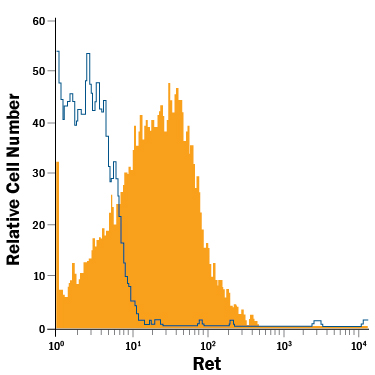Human Ret APC-conjugated Antibody Summary
Applications
Please Note: Optimal dilutions should be determined by each laboratory for each application. General Protocols are available in the Technical Information section on our website.
Scientific Data
 View Larger
View Larger
Detection of Ret in SH‑SY5Y Human Cell Line by Flow Cytometry. SH-SY5Y human neuroblastoma cell line was stained with Mouse Anti-Human Ret APC-conjugated Monoclonal Antibody (Catalog # IC718A, filled histogram) or isotype control antibody (Catalog # IC002A, open histogram). To facilitate intracellular staining, cells were fixed with Flow Cytometry Fixation Buffer (Catalog # FC004) and permeabilized with Flow Cytometry Permeabilization/Wash Buffer I (Catalog # FC005). View our protocol for Staining Intracellular Molecules.
Reconstitution Calculator
Preparation and Storage
Background: Ret
The GDNF family of neurotrophic factors forms a subfamily within the TGF-beta superfamily. These proteins are potent survival factors for various central and peripheral neurons during development and the adult animal. The GDNF family members (GDNF, neurturin, artemin and persephin) signal through multicomponent receptors that consist of the Ret receptor tyrosine kinase and one of four glycosyl-phosphatidylinositol (GPI)-linked ligand-binding subunits (GFR alpha -1-4) (1). GFR alpha -1 -2, -3 and -4 are the preferred ligand-binding subunits for GDNF, neurturin, artemin and persephin, respectively. The Ret tyrosine-kinase receptor is a 170-175 kDa type I transmembrane glycoprotein that is encoded by the c-ret proto-oncogene (2,3). Mutations of the ret gene have been associated with various human diseases affecting tissues derived from the neural crest, including Hirschsprung’s disease, multiple endocrine neoplasia MEN2A and MEN2B, and familial medullary thyroid carcinoma (4). Human and mouse Ret share 83% amino acid (aa) sequence identity (77% identity in the extracellular domain over aa 29-635). Although Ret does not bind GDNF ligands directly, in general, the extracellular domain of Ret binds the GDNF-GFR-alpha complex with high affinity and is a potent GDNF antagonist in the presence of soluble GFR-alpha (5-6).
- Wang, X. (2013) Biochim. Biophys. Acta. 1834:2205.
- Takahashi, M. and G.M. Cooper (1987) Mol. Cell Biol. 7:1378.
- Richardson, D.S. et al. (2012) Mol. Cell Biol. 23:3838.
- Mulligan, L.M. et al. (2014) Nat. Rev. Cancer 14:173.
- Ibanez, C.F. (2013) Cold Spring Harb. Perspect. Biol. 5:a009134.
- Plaza-Menacho, I. et al. (2014) Cell. Signal. 26:1743.
Product Datasheets
Citation for Human Ret APC-conjugated Antibody
R&D Systems personnel manually curate a database that contains references using R&D Systems products. The data collected includes not only links to publications in PubMed, but also provides information about sample types, species, and experimental conditions.
1 Citation: Showing 1 - 1
-
Glial-cell-derived neuroregulators control type 3 innate lymphoid cells and gut defence
Nature, 2016-07-13;535(7612):440-3.
Species: Mouse
Sample Types: Whole Cells
Applications: Flow Cytometry
FAQs
No product specific FAQs exist for this product, however you may
View all Antibody FAQsReviews for Human Ret APC-conjugated Antibody
There are currently no reviews for this product. Be the first to review Human Ret APC-conjugated Antibody and earn rewards!
Have you used Human Ret APC-conjugated Antibody?
Submit a review and receive an Amazon gift card.
$25/€18/£15/$25CAN/¥75 Yuan/¥2500 Yen for a review with an image
$10/€7/£6/$10 CAD/¥70 Yuan/¥1110 Yen for a review without an image

